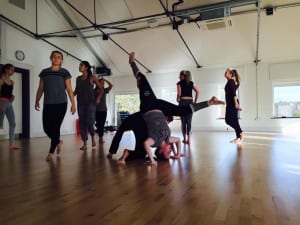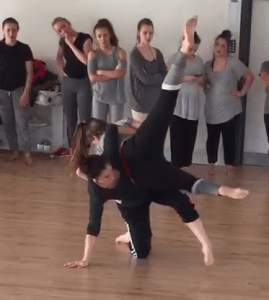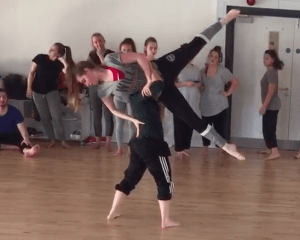– Structuring, investigating, performing and reflecting.
On Sunday the 13th of November we travelled to Nottingham’s Dance4 to take part in a workshop with Feet off the Ground Dance. Feet off the Ground Dance are a dance company that specialise in contact improvisation and partnering for performance. They aim to leave their participants feeling inspired, energised and with an embodied confidence. This 3-hour workshop was one of the rare times I really enjoyed contact improvisation. I discovered that it wasn’t contact I was afraid of, it was improvising. Being lifted or lifted something is not what makes me feel nervous, it’s the improvising part. However, our skills seem to be a lot stronger during improvising as with contact we lose some of the fundamental skills. For the first time we learnt a contact duet sequence, and this is something I really enjoyed. At first, I did find it difficult, but after a few practices with my partner I felt confidence and comfortable. We are going to be revisiting this chorography over the next few weeks and now that I know the material I am going to try to focus more on the fluidity of the exercise, find more release in my body and identify my breath and examine how that helps my movement and performance. During this workshop I left my body and mind wide open, I was prepared to take on and try anything and I feel as if this drew a lot more material, options and concepts into my body. “When we don’t make fences around our bodies, all movement becomes acceptable” (Curtis, 1988, 159). I found a new found confidence within myself and really liked the material they were giving us. It was a changeling class, but this resulted into a successful outcome.
Photos from the workshop:



Images from the duet sequence:



Bruce Curtis and Alan Ptashek in ‘Exp osed to Gravity’ talk about a man finding a new found confidence and new ways of movement through contact improvisation. This reading made me realise that contact improvisation really can be for anyone, weather you have restrictions in your body or not. Curtis has a spinal cord injury and is in a wheelchair, but he explains that he doesn’t let this limit his range of movement; “It seemed pretty clear to me, whatever the reason, that for me to dance, the method would have to come from my personal experience of how my body moves, not from copying how non-disabled people move.” (Curtis, 1998, 156). To him “the micro movement is just as much dancing as what everyone else does with their whole body” (Curtis, 1998, 156). The experience of dancing is different to everyone. Weather that person has a minor injury, a major injury or no injury at all, the experience will always be different in someone else’s body and I think it is important to recognise that. But that injury or disabled difference, doesn’t mean they can’t dance or that they are any less able than a ‘non-disabled’ person and if they dance in a different way that’s not wrong either, dancing is different to everyone.
During our research lab this week we decided to focus on confidence with going up into weight baring lifts. Our question was ‘How do we use the 3 stages of preparation to develop confidence in weight baring lifts’. Through the connection of another body in the space Curits and Ptashek discuss the usage of momentum and weight exchange in order to help dancers gain fearlessness in weight baring lifts and this is something that really related and helped our practice. The idea of our research lab was to challenge the class in order to find these new ways of lifting, we wanted to throw them out of their comfort zones, but try to ensure that they stay focused and that they didn’t let the uncomfortableness distract their mind set or process of movement. We started off with giving them tasks we had explored previously in class; keeping contact whilst travelling across the room. The first exercise involved travelling in ways such as body surfing and from table top, but no weight baring at this point. We gave the class advice of keeping “your eyes open, don’t get lost inside your head. Look for opportunities to support your partner, move in underneath them. Don’t give or take weight without listening for the agreement of your partner’s body.” (Curtis, 1998, 158). We then went onto develop the exercise further by changing the point of starting and the idea of safe position, this way was to have one person start from table top position and the other to start from standing. This exercise was exactly the same as the first but just from a different starting position, we wanted the class to try to experiment and explore new ways of moving and keeping that connection. The starting position slightly changed the way the dancers moved, the movement was a little bit more original than before, but overall this exercise was quite basic for our class, we saw a lot of already known movement and things we had already done in class, so we wanted to push them a little more to try and identify new things
“Mutual trust is based on uncompromised attention, so stay in the present moment” (Curtis, 1998, 158). The next exercise was what we called reverse practice, this involved everyone starting from standing, when usually and previously we had started from table top. Standing was also our safe position, so if anyone ever got stuck, they could go back to this position and start again. The aim of this exercise was to expand onto the dancer’s knowledge of exploring ways of going from standing to table top, and table top to standing. It focused on the idea of weight baring, so we wanted our class to explore this as much as possible but in NEW ways… one way we tried to inforce this was by banning body surfing as we felt that this is something the dancers always went back to once they were stuck and we wanted to try and avoid this! We then went onto banning table top as well as body surfing, so this really made our dancers think outside of the box. This meant that the dancers had to find ways to weight bare ONLY from standing to get to the other side of the space. “A dance form that uses movement, gravity and their relationship to each other as revealed through changing points of balance” (Curtis, 1998, 158). This really tested our classes mind as well as ability, but we learned that it worked. By banning the two major positions that we use in class, enabled the dancers to explore new ways of moving within the air, some didn’t even need table top or body surfing, original and interesting movement was created.
Our feedback showed us that the majority of our class thought that by building up the stages slowly developed confidence, some quicker than others, but they thought it was better than just going straight into standing weight baring lifts. Our idea of restricting movement to aid more movement to be developed worked because 15 out of 20 people thought that by banning certain movements encouraged them to form something more original. Our overall idea of our research lab was successful, 13 members of the class felt more confident after our session to explore and put these new movement methods into practice within a jam session and hoped that they would continue to build their confidence in weight baring lifts. As an overall session the majority of the movement I saw was new, on the odd occasion I saw repeated movement and movement we had completed within in class, but it was really interesting to see the dancers get ‘stuck’ and manage to get themselves out of this situation with new, original, safe movement.
Pictures from our research lab:




I feel that a lot of trust was formed within this week. I saw people work with people I hadn’t witnessed them work with before, a new energy was formed within the class. Within jams people are starting to get a lot more confidence and the space is nearly never empty. People are starting to improvise in groups more than 2 people, although this is very difficult I see people trying. I am still finding it difficult to get myself back into the jam once I have left the space because I am waiting for another person to be ‘free to dance with’. This is something I need to stop doing, I need to enter the space on my own, explore my own, individual improvisation skills and wait for someone to make contact with me or join a duet. I think the confidence is starting to come, I now have all the skills… I just need to apply them to my practice.
Curtis, B. (1988). Exposed to Gravity. Contact Quarterly/ Contact Improvisation Sourcebook I, Vol. 13













